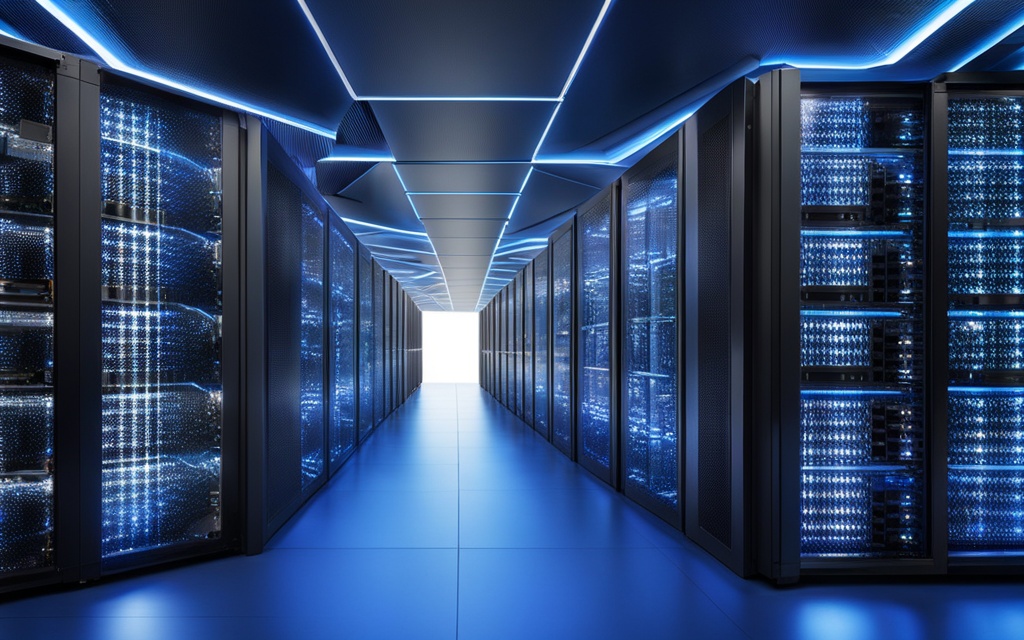Table of Contents
High-performance computing (HPC) storage helps manage huge data amounts today. We explore the latest trends and tech in HPC storage, highlighting efficient data handling. With the first supercomputers, HPC has changed a lot. Now, we need new storage solutions for complex maths and data analysis. Important trends include AI use, moving to cloud computing, and starting edge computing. These trends improve efficiency and meet the need for better data analysis. The Frontier supercomputer in the US, with a speed of 1.206 exaflops, shows what modern HPC can do1. Also, organisations spent 62.4% more on scalable computing in 2023, hitting USD 85.7 billion globally1.
Key Takeaways
- High-performance computing storage is vital for managing vast data volumes.
- Recent trends indicate a significant shift towards AI integration in HPC systems.
- The cloud now offers scalable and affordable HPC, with major providers like AWS and Microsoft Azure.
- Robust data management strategies are essential for optimising HPC storage systems.
- Modern HPC systems, such as Frontier, demonstrate remarkable advancements in processing capabilities.
Introduction to High Performance Computing
High performance computing (HPC) is a big leap in computing technology. It lets us solve complex problems that need lots of processing power. Definition of HPC includes using several processors at once and special hardware like multi-core CPUs and GPUs. This way, people in research and industry can do simulations, maths, and analyse data effectively.
HPC is used in many areas like finding new medicines, predicting market trends, and making things work better in real-time. It’s changing how quickly we can innovate in these areas. The push for quick data analysis is growing. HPC systems are now more crucial for huge simulations and AI, boosting computing power in various fields2.
HPC started with systems like the CDC 6600, opening a world that keeps evolving. Today, HPC clusters have lots of nodes tailored for different tasks. For instance, one cluster might have 105 nodes split into parts for big memory needs or GPU jobs3. Each part aims to get the most out of intense computing jobs.
The use of HPC is soaring because it can handle huge data sets. This is vital in areas like self-driving cars and detailed medical treatments. As HPC technology becomes simpler to access, its use spreads further. This drives new solutions in our fast-changing world2.
| Partition | Nodes | CPUs | Memory per Node | Special Features |
|---|---|---|---|---|
| Bigmem | 4 | 48 | 2TB | Optimised for memory access |
| Compute | 41 | 48 | 256GB | Intel Xeon Gold 6342 CPUs |
| GPU | 14 | 48 | 512GB | NVIDIA A100 GPUs |
| Quickq | 46 | 48 | 256GB | Optimised for short-duration tasks |
Key Components of High Performance Computing Storage
Understanding how storage systems work in High Performance Computing is key. They are vital for the efficiency and success of computational tasks. HPC includes compute, storage, and more, each vital for system performance. As HPC evolves, storage needs grow to handle more data.
In 2018, the HPC market was valued at $27 billion. It’s expected to grow by 7.2% annually, reaching $7.8 billion by 2023. This growth shows the increasing demand for storage systems that can handle big datasets4.
Modern storage systems need to provide quick and efficient data access. An HPC cluster often has over 100,000 nodes, needing fast data retrieval4 and5. These setups usually include a variety of nodes, each with a specific function.
HPC is crucial for many uses, from research to simulations. Companies depend on effective storage systems for quick data analysis in many areas5. Knowing about these components helps understand their importance in driving innovation and processing data.
| HPC Component | Purpose |
|---|---|
| Compute Nodes | Perform calculations and processes |
| Storage Nodes | Store and manage data |
| Network Fabric | Facilitate communication between nodes |
| Software | Manage resources and workloads efficiently |
Adding GPU-accelerated hardware boosts HPC systems’ capability for large computations. With modern servers having up to 64 cores, fast data access is ever more crucial4.
Current Trends in High Performance Computing Storage
The world of high-performance computing (HPC) is changing fast. We’re seeing the emergence of Artificial Intelligence in Storage. This is totally changing how we manage storage. Because of the growing need for data, companies are using artificial intelligence to boost their HPC. This makes data centres work better, thanks to things like predictive maintenance and using energy more wisely. These big changes have happened in the last five years6.
AI is becoming more important in HPC, especially for keeping things secure. It can spot dangers that normal methods might miss. At the same time, we’re moving towards processing data closer to where it’s collected, thanks to edge computing. This method is made even quicker with 5G technology6. Innovative ideas are being born in startups focused on high-performance tech. They’re making waves globally7.
Cloud services like Amazon Web Services and Google are now offering HPC as a Service (HPCaaS). This gives businesses a flexible way to meet their high demands without a fixed cost. For example, Pure Storage’s FlashBlade offers quick access to files and storage. It’s perfect for today’s complex HPC tasks6.
We’re also looking forward to exascale computing. It aims for speeds beyond one exaflop by 2023. This pushes the need for better storage that can handle such massive processing power8. Keeping storage management strong and ready for the future is key. It helps high-performance computing keep advancing.
Advantages of Edge Computing in HPC Storage Systems
Edge computing is changing how High Performance Computing (HPC) storage systems work, offering many advantages. It significantly quickens data processing by doing it closer to where data comes from. For example, manufacturers using HPC at the edge see less delay, which helps them be more productive and efficient9.
HPC at the edge is scalable, meaning it can grow as needs change. This is perfect for fields that handle a lot of data. Hyperion Research says the market for server-based AI and edge computing is expected to increase quickly, reaching over $1.6 billion10. This highlights how important real-time data analysis is becoming in many areas.
With edge computing, companies can better manage their supply chains and stock. This lowers costs and helps get products to customers faster. Predictive maintenance also means machines last longer and work is less likely to be stopped, improving things even more9.
Many sectors, including healthcare, manufacturing, and entertainment, benefit from HPC at the edge. These industries offer engaging and immersive experiences. As things keep changing, it’s very important to use edge computing10.
| Industry | Use Cases | Benefits |
|---|---|---|
| Manufacturing | Real-time Analytics, Predictive Maintenance | Enhanced Productivity, Reduced Downtime |
| Healthcare | HPC in Diagnostic Machines | Regulatory Compliance, Space Efficiency |
| Entertainment | Immersive Experiences | Audience Engagement, Enhanced Interactivity |
How GPU Computing Transforms Storage Capabilities
GPU computing has changed the game in High Performance Computing (HPC) storage systems. These processors are great at doing many tasks at the same time. This boosts the speed of data handling and manages big datasets well. Sectors like finance, machine learning, and healthcare see big benefits from GPUs. They do complex calculations quickly, much faster than old CPUs11.
Now, many companies use GPU cloud computing. It helps with machine learning, AI, and big data analytics. The use of shared GPU resources lets teams adjust the GPU power they need. This helps save money and optimises resources. Such flexibility leads to innovation, letting new solutions come to life quickly12.
GPU as a Service (GPUaaS) makes a big difference. It lets organisations use GPU power without buying expensive hardware first13. In financial modelling and medical imaging, GPUaaS speeds up important tasks. It helps with better decision-making and improved results. It also makes it easier for teams to work together, no matter where they are13.
GPUs offer more than just speed. Thanks to their design, they can handle tough tasks well. For instance, GPU clusters in HPC systems work with advanced tech. This leads to faster task completion and supports analytics work. It’s important for organisations to teach their staff about these technologies11.
The demand for better data handling keeps growing. Adding GPU computing to HPC systems is a major change. It brings better speed, flexibility, and teamwork. This shows how crucial GPU tech is for improving data management1213.
Challenges in High Performance Computing Storage
The landscape of High Performance Computing (HPC) storage is full of challenges. These primarily come from data complexity and ongoing management issues. One big problem is the huge amount of data produced, which can be up to hundreds of Petabytes. This makes it hard to organize and manage storage effectively14. Also, new HPC workloads, like in bioinformatics and machine learning (ML), often need to store data in millions of small files. This increases the data complexity even more14.
HPC systems must offer consistent low latency across many parallel streams. Another issue is with traditional hard drives, which can cause delays when accessing multiple files. For example, accessing a thousand files might take up to 10 seconds14. As all-flash storage systems are often too expensive, a mix of flash for active data and HDD for less active data is used14.
Older data centres struggle with the demands of HPC workloads. This brings up management challenges due to outdated infrastructure. Adding accelerators and multi-core processors increases system complexity. This makes it harder to forecast workloads and optimize code15. A lack of unified system architecture also leads to data silos and uneven experiences in hybrid-cloud environments15.
Addressing strong governance and security is crucial in shared HPC clusters, especially for critical data15. Without the right skills in managing and tuning clusters, organizations could see poor performance and low returns, worsening data complexity15.
Many developers understand the need for effective tools in scenarios with millions of files. However, the market for such tools is small and unstable16. The gap between needs and available solutions can hinder innovation and pose risks for companies that can’t keep up with tool development16.
In the end, the evolution of HPC calls for a sharp focus on overcoming management challenges. It’s about having a strong strategy to deal with the complex nature of data complexity in storage systems.
Future Technologies Shaping High Performance Computing Storage
Quantum computing is changing high-performance computing (HPC) storage. It makes complex calculations quickly, changing how we manage and analyse data. Quantum technology in HPC could solve big challenges, opening new doors for data processing.
By 2023, the HPC market was worth USD 55.71 billion. This shows a strong interest in new technologies17. It’s expected to grow by 10.94% each year until 2029. The trend towards using systems on-site is growing17. These systems meet specific needs better and boost performance.
In North America, HPC technology adoption is high17. Systems now reach a total of 8.2 exaflops and could go up to 12.5 petaflops. This boosts innovation in many areas18. About 27% of this power comes from leading systems, Aurora and Frontier18. This pushes us to rethink how we process data, marking a key moment for tech development.
The main aim is to improve efficiency with scientific computing. This area depends more on HPC scientific computing technologies today. With 162.8 million cores in use, the power of modern HPC solutions is clear18. Quantum computing will lift HPC to new levels of performance and efficiency.
Big names in the HPC world include Advanced Micro Devices Inc., NEC Corporation, and Microsoft Corporation. They’re behind the trends and breakthroughs in high-performance computing storage17. This dynamic field has huge potential for new discoveries.
Conclusion
The world of high performance computing (HPC) storage is changing fast. Organisations must keep up with new tech to manage large datasets. Modern HPC systems can deal with hundreds of petabytes and offer high speeds. This makes it vital for companies to use storage systems that can grow with their needs19. Cloud services and hybrid environments are becoming popular. They offer flexible structures that allow quick data analysis for different industries20.
HPC has huge potential. It helps industries carry out big data tasks very quickly. This is good for research and important business decisions21. With AI and quantum computing merging, organisations can stay ahead by using faster processing power20. Embracing these new technologies is key to the future of data processing and storage.
In short, HPC storage is not just changing; it’s rapidly advancing. This is thanks to things like solid-state drives and quick interconnects. Companies need to stay proactive. By doing so, they can lead in this fast-moving era of storage technology1921.
FAQ
What is high-performance computing storage?
High-performance computing (HPC) storage is all about top-notch systems. They handle huge amounts of data from intense computing work. These tools are key for quick data access and reliable data management.
How does artificial intelligence integrate into HPC storage?
AI improves HPC storage by making better use of resources. It automates standard tasks, and makes maintenance smarter. AI also steps up security in HPC areas by spotting odd and threatening activities.
What advantages does edge computing offer in HPC storage systems?
Edge computing boosts data processing speed and cuts down on wait times. It works by handling data closer to where it’s created. This is great for tasks needing instant analysis, like self-driving cars and precision manufacturing.
Why are GPUs important in high-performance computing storage?
GPUs matter a lot because they’re ace at doing many things at once. This lets them speed through heaps of data tasks fast. That’s why they’re a must-have for heavy-duty calculations and data-heavy jobs.
What challenges do organisations face with HPC storage?
Companies run into a few bumps with HPC storage, especially as data mountains grow. Getting data quickly, keeping it correct, and making sure everything runs well are just a few headaches. Good data management rules are crucial.
How is quantum computing expected to impact HPC storage?
Quantum computing is going to be a game-changer for HPC storage. It will crunch through complex sums super fast. As quantum tech gets better, it’ll open new doors for managing and analysing data, solving big puzzles
What are the current trends in high-performance computing storage?
The latest HPC storage trends include mixing in AI, moving to the cloud, and getting started with edge computing. These steps help companies be more efficient, scalable, and speedy, meeting the rising need for top-tier data analysis.
Why are modern storage solutions essential for organisations?
Modern storage setups are vital for companies looking to tap into large data pools. By picking cutting-edge HPC storage that grows with their data, organisations can boost their computing power and keep their edge in a data-first world.
Source Links
- https://www.ibm.com/topics/hpc – What Is High-Performance Computing (HPC)? | IBM
- https://www.intel.com/content/www/us/en/high-performance-computing/what-is-hpc.html – What Is High Performance Computing (HPC)? – Intel
- https://help.sdstate.edu/TDClient/2744/Portal/KB/ArticleDet?ID=159597 – High Performance Computing (HPC)
- https://www.weka.io/learn/hpc/what-are-hpc-and-hpc-clusters/ – Introduction to HPC: What are HPC & HPC Clusters?
- https://cloud.google.com/discover/what-is-high-performance-computing – What is high performance computing?
- https://blog.purestorage.com/perspectives/5-trends-shaping-the-future-of-high-performance-computing/ – 5 Trends Shaping the Future of High-performance Computing
- https://www.startus-insights.com/innovators-guide/high-performance-computing-trends/ – Top 10 High-Performance Computing Trends (2023) | StartUs Insights
- https://www.hpcwire.com/2023/07/12/top-5-trends-in-hpc-for-the-first-six-months-of-2023/ – Top 5 Trends in HPC for the First Six Months of 2023
- https://oper8global.com/hpc-at-the-edge-manufacturing/ – The Potential of High-Performance Computing (HPC) at the Edge: A Significant Shift in Manufacturing – Oper8 Global
- https://www.edgeir.com/wp-content/uploads/2021/01/oss-whitepaper-high-performance-edge-computing.pdf – PDF
- https://www.weka.io/learn/hpc/gpu-and-hpc-explained/ – HPC & GPUs Explained (How They Work Together)
- https://www.tierpoint.com/blog/gpu-cloud-computing-for-modern-workloads/ – The Impact of GPU Cloud Computing on Modern Workloads
- https://yotta.com/blog-the-gpuaas-revolution-transforming-hpc-and-virtual-pro-workstations/ – The GPUaaS Revolution: Transforming HPC and Virtual Pro Workstations – Yotta
- https://www.quobyte.com/storage-explained/what-is-high-performance-storage/ – What is High-performance Computing Storage? – Quobyte
- https://www.penguinsolutions.com/company/resources/newsroom/hpc-challenges-overcoming-platform-complexity – HPC Challenges: Overcoming Platform Complexity | Penguin Solutions
- https://www.hpcwire.com/2006/07/21/seven_challenges_of_high_performance_computing-1/ – Seven Challenges of High Performance Computing
- https://www.linkedin.com/pulse/top-trends-shaping-high-performance-computing-wcqpc – Top Trends Shaping the High Performance Computing Market in 2024
- https://www.hpcwire.com/2024/05/23/isc-takeaways-love-for-top500-extending-hpc-systems-and-media-bashing/ – ISC 2024 Takeaways: Love for Top500, Extending HPC Systems, and Media Bashing
- https://www.pdl.cmu.edu/PDL-FTP/Storage/Its_Time_to_Talk_About_HPC_Storage.pdf – It’s Time to Talk About HPC Storage: Perspectives on the Past and Future
- https://iconoutlook.com/high-performing-computing-hpc-why-we-need-it/ – High Performing Computing (HPC) Why we need it – ICON Outlook
- https://www.redhat.com/en/blog/high-performance-computing-101 – High performance computing 101








